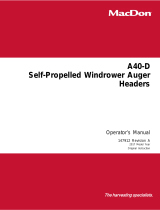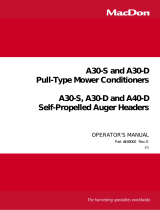Page is loading ...

NOTE: REFER TO THE AUGER HEADER OPERATOR’S MANUAL FOR DETAILED ADJUSTMENT INSTRUCTIONS.
NOTE: THESE SETTINGS ARE INTENDED AS A STARTING POINT. ADJUST TO CROP AND FIELD CONDITIONS.
Feed Pan/Rock Tine Position (6)
Roll Gap (7)
Header Angle (1)
Roll Gap (7)
Operating Variables
A-Series Model
A40-D Self-Propelled A30-D Pull-Type
Header
Angle
(1)
Header angle is the angle between the
guards and the ground. Adjustable to
accommodate soil type and/or conditions.
Determined by length of
hydraulic center-link and
displayed as a value from 0
(shallow) to 10 (steep) on the
windrower control module
(WCM). Adjust with controls in
windrower cab.
Mechanical Link:
Indicated by length of link:
• Short for shallow
• Long for steep
Hydraulic Link:
Indicated by gauge on cylinder:
• No holes exposed for shallow
• All holes exposed for steep
Knife
Speed
(2)
• Heavier grass crops require higher knife
speeds.
• Lighter grass and hay crops require lower
knife speeds.
Displayed as strokes per
minute on the windrower cab
display module (CDM). Adjust
with controls in windrower cab.
• Varies with tractor PTO speed. Manual
measurement required.
• Two speed ranges available by
swapping primary pulleys.
Knife speed (SPM) 1400–1950
Factory
No load 1983
Load 1912
Swapping pulleys
No load 1749
Load 1687
Reel
Speed
(3)
• Operate the reel at suggested rpm
in chart.
• Reel speed can operate as a percentage
of ground speed in certain windrower
models. Refer to windrower operator’s
manual for detailed instructions.
Displayed as mph, km/h, or
rpm on the windrower cab
display module (CDM). Adjust
with controls in windrower cab.
Optional drive sprockets provide different
ranges and also variable with tractor PTO
speed.
Auger
Speed
(4)
• Increase auger speed at high ground
speed or in heavy crop conditions.
• Decrease auger speed at low ground
speed or in light crop conditions.
• Refer to auger header operator’s manual
for detailed adjustment instructions
Displayed as an index value on
the cab display module (CDM).
Values range from 4.7–9.9.
Adjust with controls in
windrower cab.
Optional drive sprockets provide different
ranges and also variable with tractor PTO
speed.
Float
(5)
• Normal float setting requires 75–85 lbf
(334–378 N) of lifting force at front end of
header, with lift cylinder retracted and
header at desired cutting angle.
• Increase float setting in rough terrain or
at high ground speeds to prevent
excessive header movement.
Adjustable springs on the
windrower header lift system.
Use in-cab controls for fine
adjustments.
Adjustable springs on header lift system.
Feed
Pan/Rock
Drop Tine
Position
(6)
• Lower the feed pan in heavy crop to help
prevent plugging.
• Raise the feed pan in light crop to form
an even windrow.
1. Loosen bolt (A) at each end.
2. Move tines and pan (B) as required.
3. Tighten bolts (A).
Roll Gap
(7)
Roll gap (C) determines the amount of
conditioning and is preset at 1/4 in.
(6 mm).
• Increase roll gap to reduce conditioning: Loosen jam nut (D), and turn
lower nut (E) clockwise. Tighten jam nut (D).
• Reduce roll gap to increase conditioning: Loosen jam nut (D) and turn
lower nut (E) counterclockwise. Tighten jam nut (D).
Crop
Condition
Terrain
Stubble
Height
Header
Angle (1)
Knife
Speed (2)
Reel
Speed (3)
Auger
Speed (4)
Float (5)
Feed Pan
Position (6)
Roll Gap
(7)
(tons per
acre)
in. (mm) (spm) (rpm) (4.7–9.9) in. (mm)
Smooth Steep Normal
Rocky Shallow Light
Smooth Steep Normal
Rocky Shallow Light
Smooth Steep Normal/Heavy
Rocky Shallow Light
Smooth Steep Heavy
Rocky Shallow Light/Normal
Smooth Steep Normal
Rocky Shallow Light
Smooth Steep Normal
Rocky Shallow Light
Smooth Steep Heavy
Rocky Shallow Light/Normal
Smooth Steep Normal
Rocky Shallow Light
Smooth Steep Normal
Rocky Shallow Light
Smooth Steep Heavy
Rocky Shallow Light/Normal
Smooth Steep Normal
Rocky Shallow Light
Smooth Steep Normal/Heavy
Rocky Middle Light
Smooth Steep Heavy
Rocky Middle Light/Normal
Smooth Steep Normal
Rocky Shallow Light
Smooth Steep Normal
Rocky Shallow Light
Smooth Steep Normal/Heavy
Rocky Middle Light/Normal
Smooth Steep Heavy
Rocky Middle Light/Normal
Crop
Type
Triticale
Wild/Grass Hay Sudan/Tall Crop Timothy Alfalfa
Lower Slot
Center Slot
Upper Slot
(winter forage)
> 3
Variable
Lower Slot
Center Slot
Variable
2–3
< 2.5
Lodged
> 3
< 2
Lodged
Lodged
> 10
< 10
1/4 (6)
1/4 (6)
See above
5/8 (16)
See above
1 (25)
1 (25)
See above
3/8 (10)
See above
3/4 (19)
5/8 (16)
1/2 (13)
3/8 (10)
See above
3/8 (10)
1/4 (6)
Lodged
> 3.5
2–3
< 2
Lodged
> 2.5
Lower SlotHigh
Medium/High
Medium/High
1850–1950
1700–1850
73–77
70–75
Center Slot
Lower Slot70–75
65–70
70–75
1600–1800
60–65
Lower Slot
0
0
Center Slot
Upper Slot
Variable
73–77
70–75
65–70
73–77
Center Slot
70–75 Variable
Medium/High
70–75
73–77
High
Medium
Low/Medium
Low
Medium/High
High
Low
Medium/High
70–75
0
1850–1950
2.5–3
(64–76)
6
(152)
High
Medium
Low
High
Medium/High
Variable
< 3
1600–1800
70–75
65–70
65–70

A
Lean Bar
• Height should be set at 2/3 (two-thirds) of the crop height.
• In crops over 5 ft. (1.52 m), an optional Tall Crop Divider kit (MD #B4690) is available that
includes lean bar extensions to raise the lean bar.
B
Skid Shoe
• Cutting height is controlled with a combination of skid shoes or gauge rollers, and header
angle adjustment—NOT with the header lift cylinders.
• Adjust as follows:
1. Remove clevis pin (X).
2. Adjust skid shoe (B).
3. Install clevis pin (X).
C
Center Baffle
(SP Only)
• Use fully raised position for narrower windrows.
• Lower 1 or 2 notches to prevent crop from being projected over forming shield.
• Use fully lowered position for maximum swath width.
D
Reel Cam
• The reel cam at the right end of the reel controls the aggressiveness of the reel tines
which affects the crop flow into the auger.
NOTE: Right-hand cam is factory set with a 15/32 in. (12 mm) offset between front and
rear bolt heights. Maintain offset throughout adjustment. Left-hand bolt heights are equal.
• To change reel tine aggressiveness, loosen bolts securing cam disc to end sheet. Tight-
en bolts after adjusting cam disc. Refer to the header operator’s manual.
• To increase tine aggressiveness, turn front adjuster bolt to lower the front of cam disc and
turn the rear adjuster bolt to raise the rear of cam disc. Turn bolts by equal amounts.
• To decrease tine aggressiveness, turn front adjuster bolt to raise the front of cam disc and
turn rear adjuster bolt to lower rear of cam disc. Turn bolts by equal amounts.
E
Rear Baffle
• Raise or lower baffle to adjust the crop flow angle.
NOTE: SP rear baffle has handles that must be loosened to move the baffle.
• Lower positions create fluffy windrows. If baffle is too low, an uneven windrow may result.
• When using the DWA (SP), position rear baffle in highest position.
If necessary, lower the left side to direct crop onto the DWA belt.
F
Forming Shield
Adjustment
(SP Only)
• Remove hairpin, and lower or raise shield with straps to the desired height. Install hairpin.
• Generally, the fourth hole from the top is a good starting position.
• Lower the shield if crop is not hitting the top cover.
• Use highest position with the DWA (Remove center deflectors to improve
crop flow to DWA).
G
Forming Shield
Deflectors
• Adjust both side deflectors to the same hole position to ensure windrow placement is cen-
tered with respect to carrier/drive wheels.
H
Reel Position
• Maintain 3/32–13/32 in. (2–10 mm) clearance between reel tines and pan.
• Reel can be moved forward to improve crop lifting action in lodged crops, or rearward for
lighter crop conditions. The reel fore-aft offset is factory-set to 32-3/8 in. (816 mm) as
measured from the inside edge of the reel tube to the back frame member.
• Recheck tine to pan clearance following reel fore/aft adjustments.
J
Auger to Stripper
Bar Clearance
• Maintain proper clearance between auger flighting and stripper bars.
Refer to the header operator’s manual.
K
Knife Hold-Down
Adjustment
• Perform knife hold-down adjustment daily to keep the knife in contact with the guard cut-
ting surface. Refer to the header operator’s manual.
/












